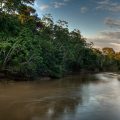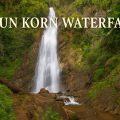The Search for Madagascar’s Elusive Waterfall: A Journey Through Ranomafana’s Wilderness
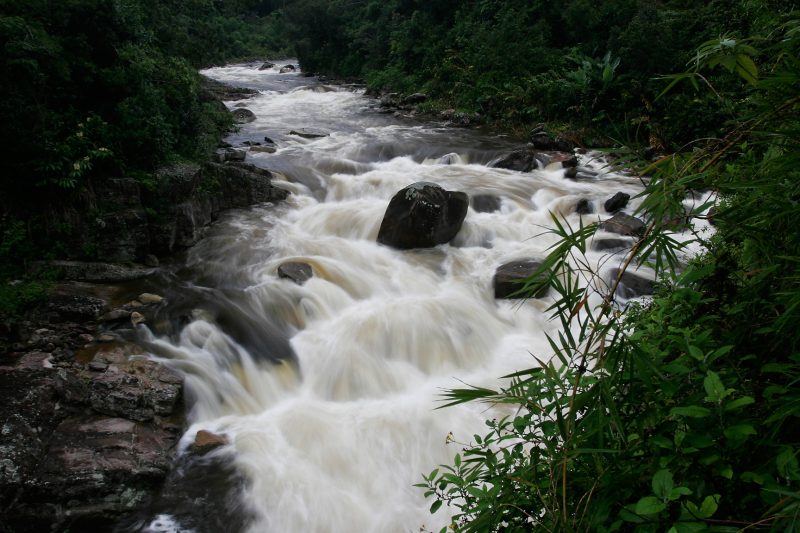
The expedition began as a simple quest—to find the largest waterfall in Ranomafana National Park, Madagascar. But as the day wore on, it became something far more profound—a journey through a primeval landscape of rivers, dense forest, and treacherous wetlands.
The first misstep was literal. My attempt to leap across the stream ended in an embarrassing, cold baptism. My feet hit a moss-covered log, slick as ice, sending me flailing before I plunged into the frigid, copper-colored water. A sharp gasp escaped me as I felt the liquid seep into my shoes, heavy as lead, dragging me down into the sodden embrace of the rainforest.
“Fantastic,” I muttered, grimacing at the realization that in this damp, tropical murk, my shoes wouldn’t dry for days. Overhead, the sky was a brooding mass of gunmetal-gray clouds, pregnant with the promise of more rain. “When does this marsh end?” I whispered, frustration gnawing at my resolve. The jungle had swallowed us whole hours ago, and we were still wading through its tangled, muddy veins.
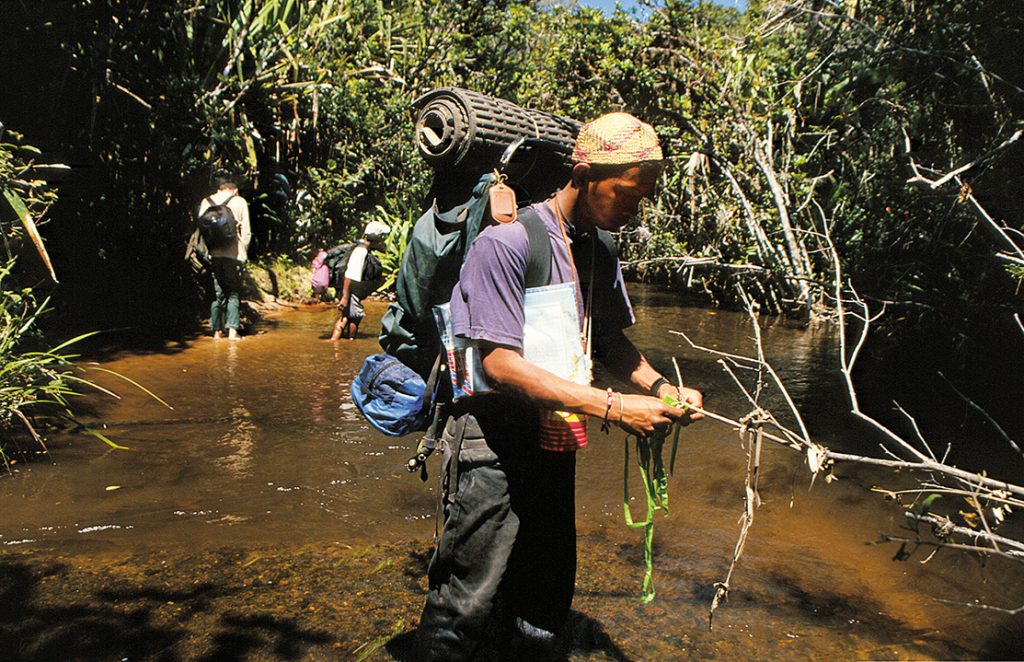
We were deep in the heart of Ranomafana, where Madagascar’s mountainous spine meets the mist-laden eastern slopes. Here, the rainforest is often wrapped in shifting veils of cloud, feeding an ecosystem as lush as it is relentless. Our small group—a trio of Croatians and a team of Malagasy park rangers—had set out from the rustic wooden homes of Ambatulahi at dawn. We had crossed rice paddies glistening with morning dew, stepping into a realm where nature ruled unchecked.
But the deeper we ventured, the wilder it became. Pandanus trees, their roots gnarled and clawing at the swampy earth, formed an almost impenetrable labyrinth. For hours, we struggled through the entanglement, each step sinking into mud, every branch a potential snare.
Our goal was simple: to carve a path to the grandest waterfall in Ranomafana, a cascade hidden deep within one of Madagascar’s most extraordinary national parks. Yet, the journey was anything but straightforward. The Red River—Ranomena, as the locals call it—twisted and turned like a living thing, forcing us to cross it again and again. Sometimes, we found salvation in fallen trees, their mossy trunks serving as precarious natural bridges. Other times, there was no choice but to wade barefoot, our shoes dangling from our hands, the icy water numbing our skin.
As the day bled into dusk, exhaustion took hold. Darkness lurked at the edges of the forest, and the relentless pace of the trek drained the last reserves of my strength. My legs, now operating on sheer instinct, stumbled over roots and rocks with no connection to my faltering mind.
This was no leisurely hike. This was an expedition for the resilient, for those willing to embrace the discomforts of the wild in pursuit of something extraordinary. The waterfall awaited—somewhere beyond the jungle’s grasp. But first, we had to survive the night.

The Pandanus Marshes: A World Suspended Between Water and Sky
Every so often, we pause—just long enough to catch our breath and let the weight of the jungle settle around us. These brief moments offer me, the biologist at heart, a chance to admire the Pandanus trees, the undisputed rulers of this swamp. Their most striking feature is their long, rigid leaves, edged with serrated teeth like natural blades, fanning out atop stout, spiny trunks. Though often mistaken for palms, they belong to a lineage entirely their own. Towering above the swamp, they brace themselves against the shifting earth with a fortress of thick prop roots, anchoring their weight as if defying gravity.
Yet these trees are more than botanical oddities—they are thriving ecosystems. Their tangled limbs cradle life in every crevice: frogs cling to their trunks, insects weave unseen highways, and even crabs scuttle among the roots, seeking shelter in the damp recesses. But not all residents are so benign. Mosquitoes—silent, insidious—breed in the stagnant pools beneath the canopy, their larvae drifting in the shadows. Among them lurks Anopheles, the infamous harbinger of malaria.
High above, out of reach, an epiphyte reigns supreme. The Arangis madagascariensis, a grand orchid with pink-red blossoms, clings to the Pandanus like a delicate crown, blooming in defiance of the swamp below.
Then, suddenly—Emile, our guide, freezes mid-step. His usual confidence falters as he scans the jungle ahead, momentarily unsure. A flicker of unease passes through me. Even he, a seasoned master of these wild trails, is navigating uncharted ground. Seconds stretch long and tense. Then, as if shaking off a spell, he claps his hands and strides forward, his signature grin restored. The unspoken message is clear: the path may be unknown, but the journey continues.
We have only an hour left to reach camp. A final surge of adrenaline pushes us forward, cutting through exhaustion like a blade. I trail at the rear of the column, side by side with our quiet, young guide, Dauphin. By the time we reach our makeshift refuge by the stream, our bodies are drained, our minds dulled by fatigue. We collapse onto the damp earth, wolfing down rice before pitching our tents. The jungle hums around us, but I hear nothing. Sleep takes me instantly.
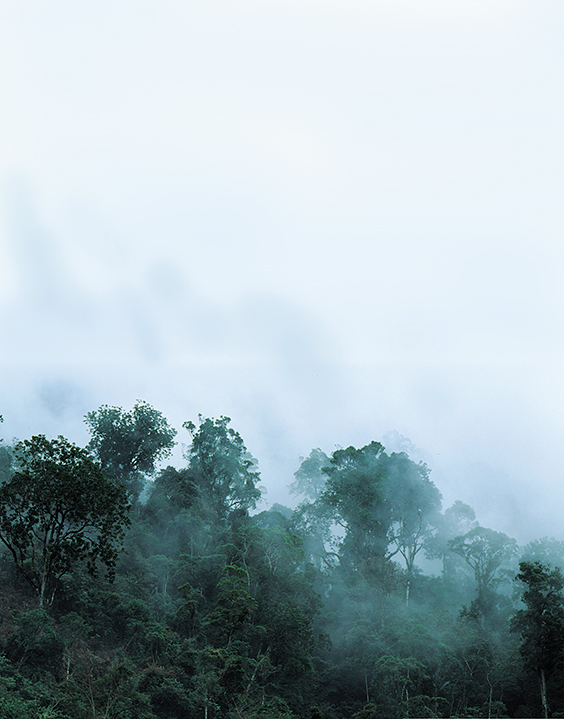
At dawn, I unzip my tent, stepping into a world thick with morning mist. The air is heavy, saturated with moisture, as low, brooding clouds drift across the treetops. A black kite circles above, its wings cutting through the gray sky, an observer of our intrusion. The Red River meanders nearby, silent and sluggish, while the Pandanus trees stand silhouetted against the fog, spectral sentinels of the marsh.
I glance at the landscape, puzzled by its peculiar flatness amidst the towering mountains of Ranomafana. Emile, sensing my curiosity, offers an explanation in his steady, measured English. “This was once a great lake,” he says. “Long ago, an adventurer blew a hole in the rock, and the water drained away, leaving behind only this marsh.”
I raise an eyebrow, skeptical. A deluge story? In a land as untamed as Madagascar, anything is possible. But as I take in the mist-draped trees and the waterlogged earth, I wonder—perhaps the wilderness holds more secrets than even the most seasoned explorers can imagine.
Plodding Through the Marsh
It is cold. Our Malagasy companions huddle wordlessly around the campfire, the only source of warmth in this mist-laden, otherworldly scene. The flickering flames cast golden reflections on the pot of simmering white rice, the undisputed staple of Madagascar. I watch it bubbling gently, a reminder of its deep-rooted importance. I recall how our guide, Emile, once had the option of a European breakfast at a hotel but instead sought out a bowl of rice on the street—a habit ingrained in culture. Yet, this same reliance on rice is a double-edged sword—the number one reason for deforestation, as vast tracts of ancient forest are sacrificed for expanding paddies.
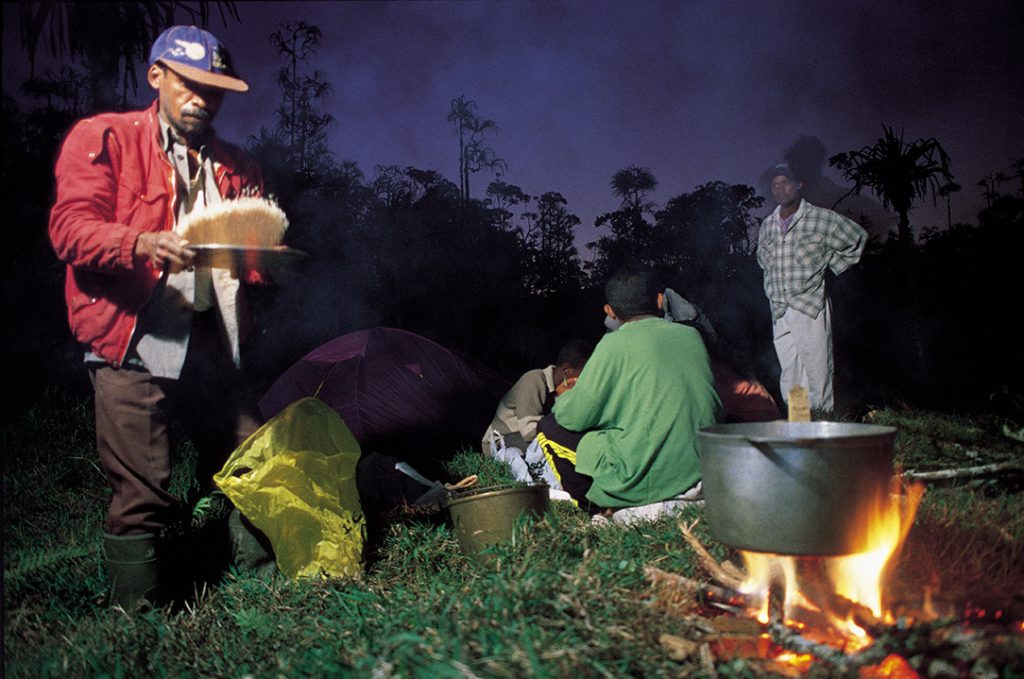
To our surprise, the clouds retreat, revealing a brilliant blue sky. The air turns balmy, a fleeting comfort before the heat intensifies. Even at 1,000 meters of altitude, the tropics spare no one. As we break camp, Emile scans the horizon, his instincts as keen as a hunting dog sniffing the wind. His verdict: we need at least one more day in the swamp.
My shoes and socks, barely dry, face another inevitable fate—more river crossings, more mud. I decide, once and for all: no more shoes. I’ll walk barefoot. Back home, on the Drava River, I’ve done this countless times—this should be no different. Besides, all our Malagasy guides are barefoot too, their soles hardened by a lifetime of unshod wandering. Only Emile, ever the professional, remains encased in his rubber boots.
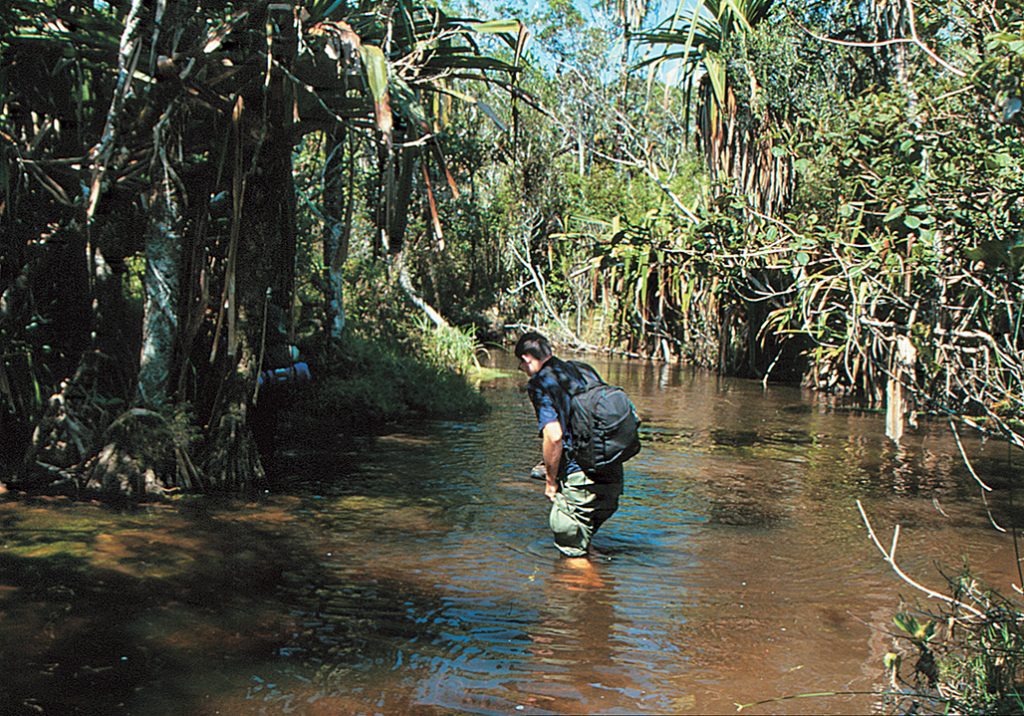
We trudge forward, following the capricious Ranomena River, a waterway as indecisive as a restless youth—twisting left, then right, never settling on a course. The river is growing wider and deeper, and the shade is vanishing, leaving us exposed. Each step is a battle. Thick mud swallows our feet, tall grass ensnares us, and young bamboo shoots slice at our legs like nature’s barbed wire. The Pandanus trees, with their thorn-rimmed leaves, become yet another obstacle, forcing us to hack through the undergrowth with machetes.
Despite the sweltering heat, we dare not strip down. The jungle has its own rules. Mosquitoes, tireless even in the full glare of daylight, hover in swarms, offering a cocktail of diseases—a risk we cannot afford. Our clothes remain our armor, but my bare feet are paying the price. Already, they are crisscrossed with bloody red welts, lacerated by razor-sharp leaves, and throbbing from yesterday’s unrelenting march.
And yet, we press on.
Lost in the Marsh
At one spot, we halt. Emile scans the surroundings, peering in all directions, but to me, everything looks the same—an endless sprawl of marshland and jungle, an indistinct maze of green. His hesitation unsettles me. He looks hopelessly lost, and for the first time, I sense that we might be in real trouble. But just as uncertainty thickens the air, an old guide steps forward, his movements deliberate.
Weathered by the sun and time itself, he is emaciated, ragged, and unassuming, a shadow at the back of our group. Until now, I barely noticed him—slouched under a huge sack of rice, moving without fuss or complaint. It occurs to me that he may not be an official park guide at all but rather a local porter, hired for his intimate knowledge of the land. He has remained silent and deferential, wary of us vazaha—foreigners in Malagasy.
Now, though, he takes the lead. Lifting his head, he sniffs the air, as if sensing an invisible trail. A few guttural words slip from his lips, his arm extending toward the unseen path ahead. Emile doesn’t question him; without a moment’s hesitation, he nods and follows. Željko, ever observant, mutters, “When nothing else helps, our ancestors’ instincts will guide the way.”
The Red River deepens, its ochre waters rising past our knees. I unroll my trousers, knowing they’ll be drenched anyway. I try not to dwell on the unseen horrors beneath the surface—parasites, bacteria, and, most disturbingly, bilharzia. This disease, pandemic in Madagascar, is caused by tiny nematodes that burrow into the skin within minutes, invading the veins of the intestines and bladder. The first sign? Bloody urine—a grim marker of infection. In time, these parasites creep into the liver and lungs, wreaking havoc. An estimated 100 million cases occur worldwide each year, the cycle perpetuated by water snails, their presence signaling danger.
I cling to a single, fragile hope—that I can stay clear of infection by keeping my immersion brief. Also, the absence of nearby settlements, the usual breeding grounds of the disease, is mildly reassuring. But doubt lingers, gnawing at the edges of my mind.
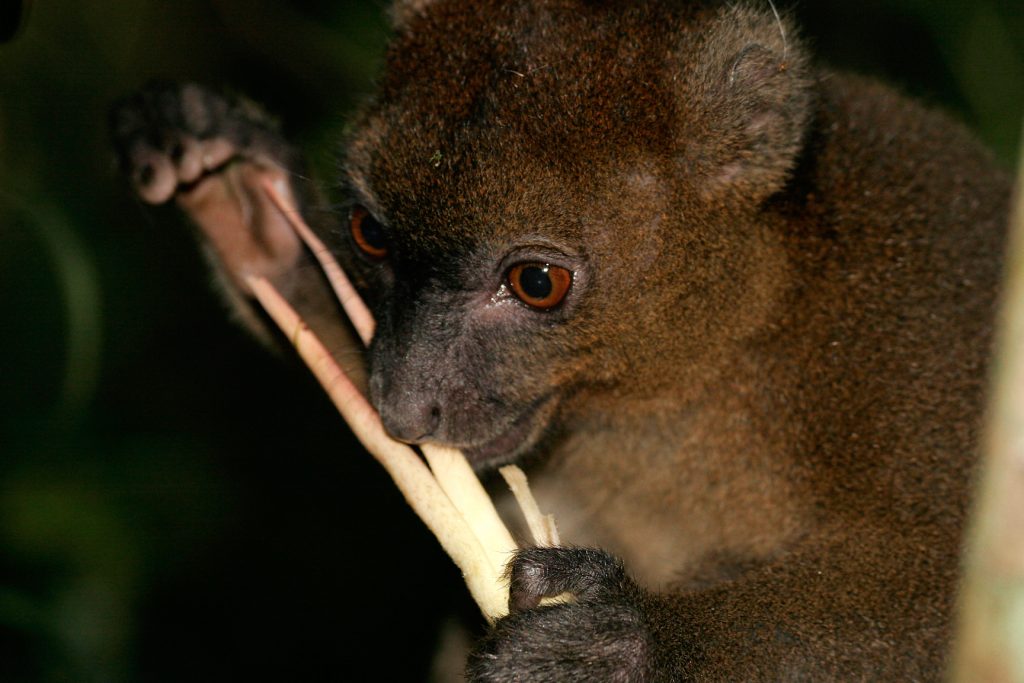
Seeking safety, I attempt to stick to the riverbanks, avoiding prolonged exposure. But here, other dangers lurk. I trip over a young bamboo shoot and, in reflex, grab onto another for support. What a mistake!
The slender stalk is covered in thousands of microscopic needles, barely visible but devilishly sharp. The moment my fingers make contact, they embed themselves in my skin, a stinging, burning sensation spreading across my hand. I look up—I’m not alone. Others in the group are wincing, plucking at their hands, victims of the same treacherous plant.
A brief panic grips me. I recall tales of a plant whose tiny spines cause unbearable pain and relentless itching, the effects lasting for weeks. But to my relief, this is just bamboo. Annoying, but not lethal. We take a few minutes to painstakingly pull out the splinters, leaving behind a curious imprint—our hands tattooed by the jungle, like ancient cave paintings etched into flesh.
And so, with burning hands and wary steps, we continue deeper into the unknown.
Down the rapids
A new sound rose from the marshy expanse, heralding the end of the stagnant waters. It was the sound of movement, of escape—the rush of running water. But not just flowing water. The unmistakable song of free-falling cascades echoed through the jungle. Suddenly, Ranomena, the river we had followed for two days, was swallowed by a narrow canyon no wider than a meter, vanishing into the shadowy depths of a sheer rock corridor. The transition was startling, a shift as abrupt as it was exhilarating.
We stepped onto a rocky promontory that had materialized at the swamp’s edge, its solid presence a stark contrast to the quagmire behind us. The fetid wetlands, once stretching as far as the eye could see, were gone. Before us lay the vast, breathing expanse of Malagasy rainforest—a living mosaic of emerald canopies, dripping with mist and mystery. The fresh air swept over us, carrying with it a cool, reviving wind that banished fatigue and rekindled our faltering spirits. But now, an unsettling question loomed. Where do we go from here?
We peered into the abyss below, its depths sending an involuntary shiver through our spines. Yet, Emile moved with unwavering confidence. Without hesitation, he began his descent into the tangled undergrowth, pushing through the dense foliage. There was no other path—we had to follow. And there, waiting for us, was our old companion, Ranomena. But she was no longer the sluggish, exhausted presence we had trudged beside for days. Here, in the depths of the forest, she had been reborn. No longer an ailing elder, she had transformed into a wild, untamed girl—alive, untethered, dancing with reckless energy. She erupted from a stone tunnel, plunging ten meters in a silver arc, before dashing headlong down the canyon, vanishing into the distance.
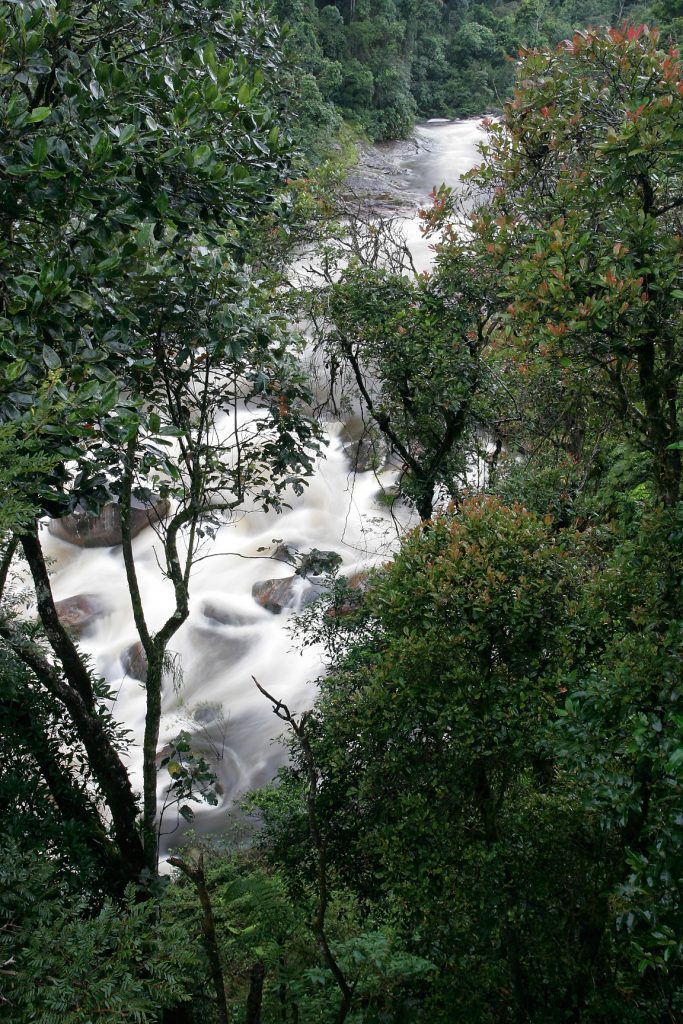
“Not yet,” Emile muttered, reading my thoughts. “That’s not the big one. We still have far to go.” His voice was dry, matter-of-fact. The rainforest ahead, tangled with epiphytes and vines, was nearly impenetrable. Our best chance? Descending along the exposed riverbed—a term that hardly did justice to the treacherous stone chasm carved by eons of torrential force. The steep, naked rock bore the scars of centuries of floods and rapids. In the rainy season, it would be a death trap. But now, in the relative calm of the dry months, there was enough space between the rapids to move forward—if we were careful.
Every step demanded attention. We sought out dry rocks, knowing the slick, algae-coated ones were an invitation to disaster. Yet, even this was no easy task—the monsoon torrents had scoured the riverbed clean, leaving only massive, immovable boulders in their wake. Stranded branches, even entire trees, lay wedged between the stones, forcing us to navigate a chaotic maze of debris.
I imagined this place during the rains—Ranomena transformed into a furious, untamable force, a roaring avalanche of water barreling downhill with nowhere to hide, nowhere to run. Now, only the white-knuckled rapids and scattered cascades remained as echoes of the beast she would become. And yet, despite the dangers, despite the grueling pace, there was something intoxicating about being here.
Occasionally, I stepped to the riverbank, seeking brief refuge from the unrelenting stone. The jungle loomed over me, an undisturbed cathedral of life. Even in the hush of the rapids, I could hear it—the unseen symphony of a million creatures. My mind conjured the electric hum of insects, the distant calls of birds hidden in the foliage, the furtive rustlings of unseen things. Vines dangled like ancient chandeliers, draped in moss and mystery, while twisted roots wrestled for space along the banks. A thick curtain of epiphytes concealed the forest’s depths in a green enigma.
I wondered—had anyone, any biologist, ever set foot here before? Had they peeled back the jungle’s veil and glimpsed the wonders hidden within?
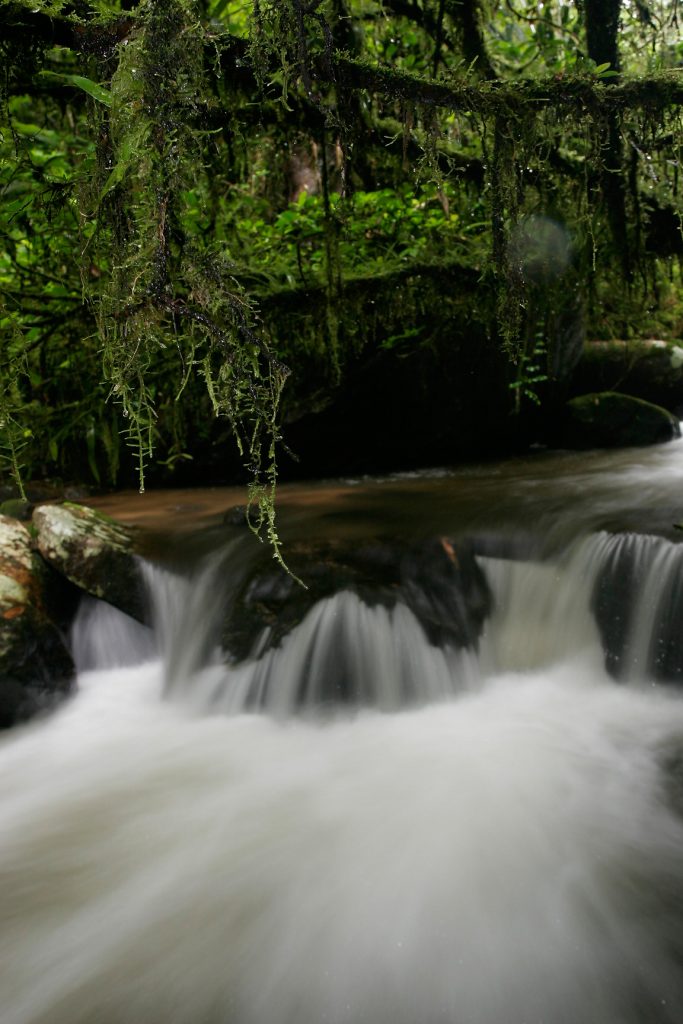
Invasion of the leeches
Nothing is eternal in this world, and the land of the falls is already gone. Ranomena is quiet once again, and our group trudges knee-deep through its course. Luckily, the shade of the living, green, intertwined roof of trees and tangled undergrowth shields us from the punishing sun and heat. We plod forward, step by step, across a bed of razor-sharp gravel, each jagged stone a torment beneath our bare soles. The pain stretches time, turning minutes into eternity.
At last, an opening in the dense thicket offers relief. The dark, fresh, cold, and soft forest floor is balmy compared to the punishing granite. Safe in the forest, the need to endure barefoot agony is over. I slip on my soaked shoes, their waterlogged weight instantly adding a kilo or two. Yet, even this is a luxury. We press on, quickening our pace, racing against the descending tropical sun. We must reach camp before darkness enshrouds the wilderness—and us within it.
But the forest’s comfort is fleeting.
A strange sensation—a tiny, writhing mouth fastening onto my skin—confirms the dreaded reality. Leeches. A full-scale invasion. A murmur of disgust ripples through the group as everyone begins the grim task of peeling them off. Their slick, pulsing bodies resist. I yank mine away, leaving them alive to seek new prey. As I do, a memory surges back—my first encounter on the other side of the park. My once-white socks had been stained rose, the blood flowing from my wounds in thin crimson streams, diluted by the deluge of tropical rain.
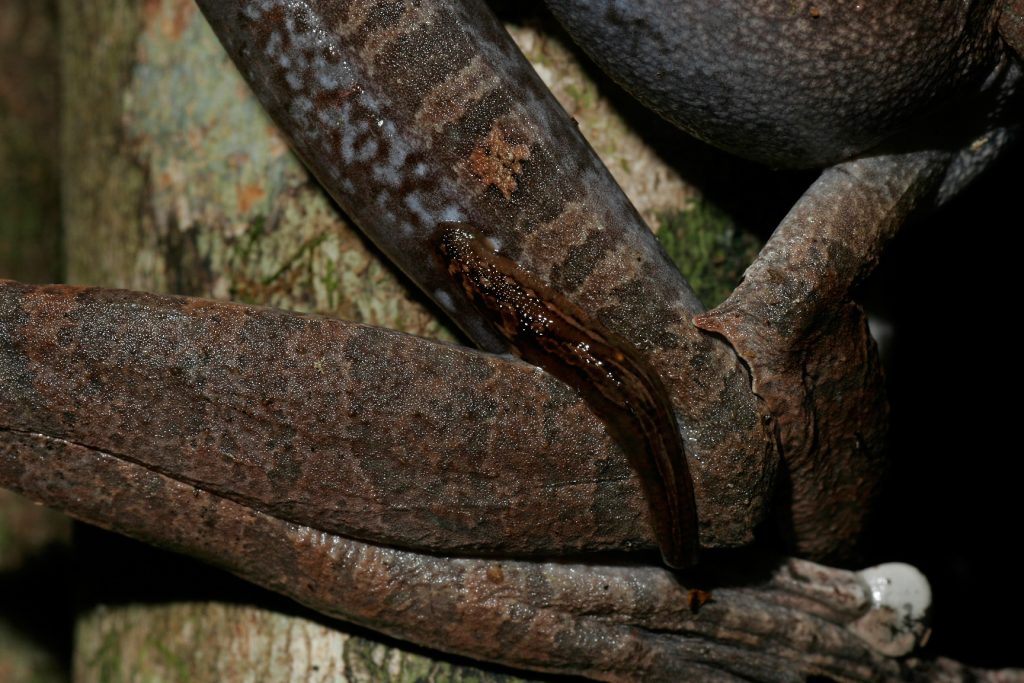
The sun is fading—it’s five o’clock, nearly nightfall in the jungle. A faint glow signals an opening ahead, where the dense forest yields to grasslands. And in the clearing, my old companions await—Pandanus trees, their spiky silhouettes swaying in the evening breeze. Emile nods with a wry smile—we are close to camp.
But the jungle has one final challenge in store.
What appears to be solid grassland is, in truth, a bog—a treacherous, waterlogged expanse of sedges, mosses, and creeping plants. As if caught in quicksand, I feel myself sink, the oozing mire sucking at my feet. Mud and water seep into my shoes again, undoing what little comfort I had reclaimed. I slog forward, the ground shifting beneath me, while the elfin trees, draped in moss and orchids, seem to mock our struggle.
At last, solid ground. We emerge—wet, muddy, bloody, but exultant.
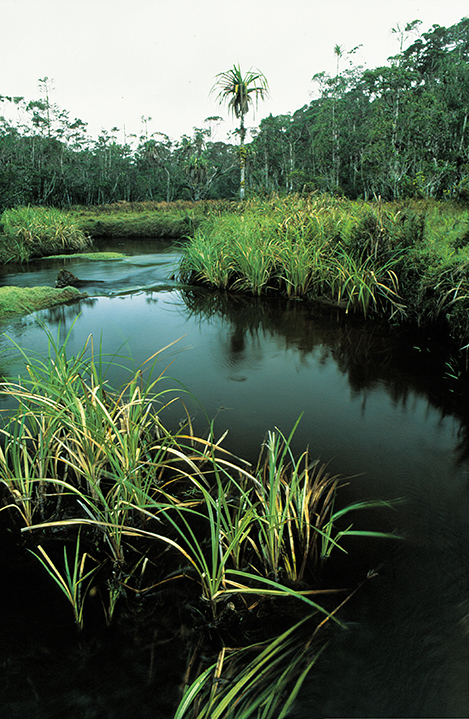
Riana Be – The Great Waterfall
The first golden rays of the newborn sun caressed the treetops, transforming them into ethereal beings, their dewdrops shimmering like scattered pearls. Closer to the ground, Ranomena remained enshrouded in a delicate mist, shifting and swirling as the morning warmth began to stir the air. She had grown—now wide and languid, a silent presence meandering through the jungle. She flowed like a princess, yet an ominous thunder rumbled through the trees, an unsettling contrast to her serenity.
We quickened our pace—just three vazahas and Emile, pushing forward as the roar of unseen power grew louder. Our goal was near, anticipation making us careless—we stumbled against tree trunks, slipped on wet rocks, and tripped over tangled roots, mesmerized by the forest’s haunting siren song. Then, suddenly, the trees broke apart, and we burst into open space, met by the rising sun perched on the horizon. The distant mountains, still veiled in fog, stretched before us—until a blinding flash from the sun made me falter, nearly toppling over the precipice.
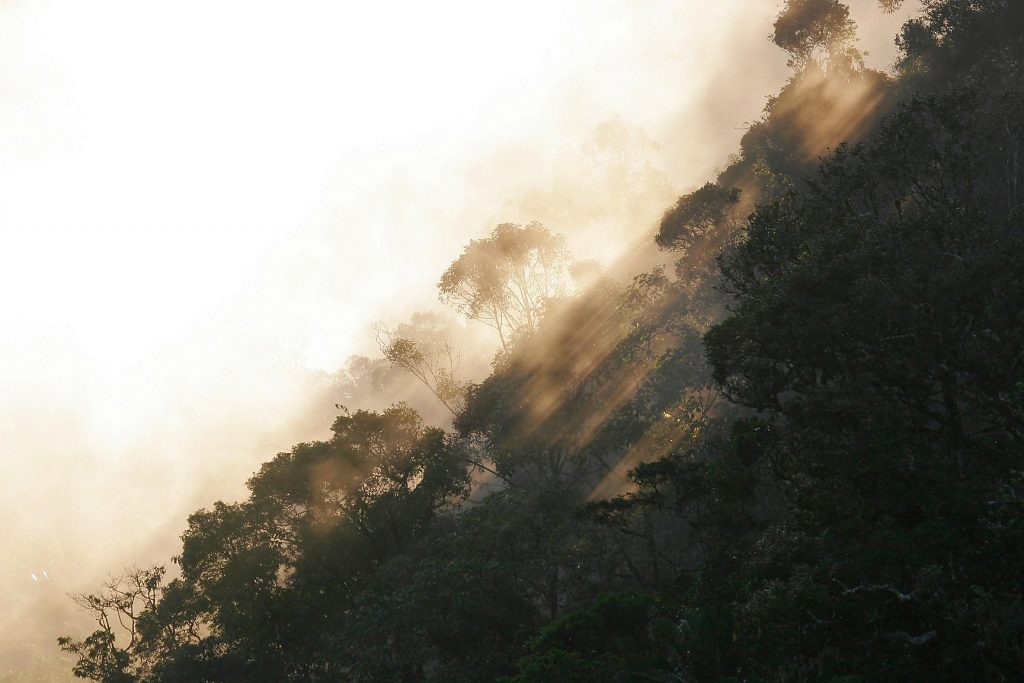
It was as if a giant hand had cleaved the mountain with a single, razor-sharp strike. And there, at the edge of the abyss, Ranomena took her final plunge. She collapsed over the cliff in a cataclysmic descent, the sheer force of her fall screaming through the canyon, leaving us deaf and voiceless. I stood on the brink, straining to see the bottom, but the churning mist swallowed all below. The fine spray, ignited by the sun, scattered in a fiery shimmer.
Like madmen, we raced downhill, reckless, grabbing trees at the last moment to save ourselves from tumbling into oblivion.
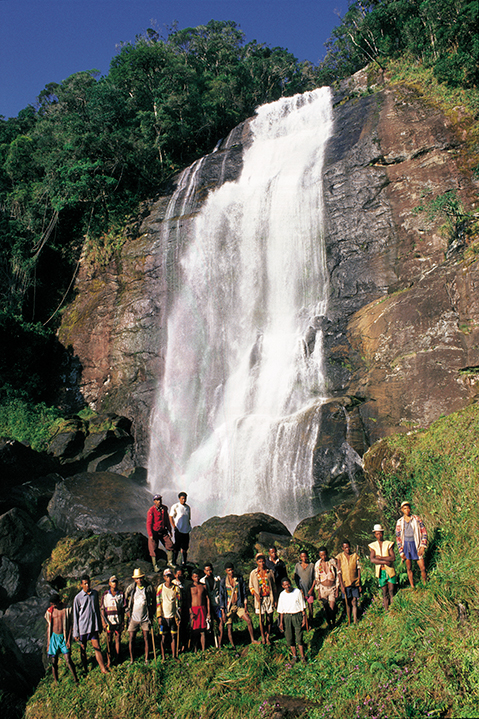
At last, we landed on a flat rock, slick with the ceaseless mist. Instantly, our skin was coated in thousands of glittering droplets. Below us, more than 40 meters high, the waterfall plunged onto dark granite, a thundering curtain of white. A rainbow danced across the cascade, its colors shifting on the swirling spray. Powerful, untamed, yet cradled on both sides by the emerald embrace of the rainforest—a rainforest that feeds and protects this life-giving water, yet is vanishing across Madagascar, surviving only in places like Ranomafana National Park.
